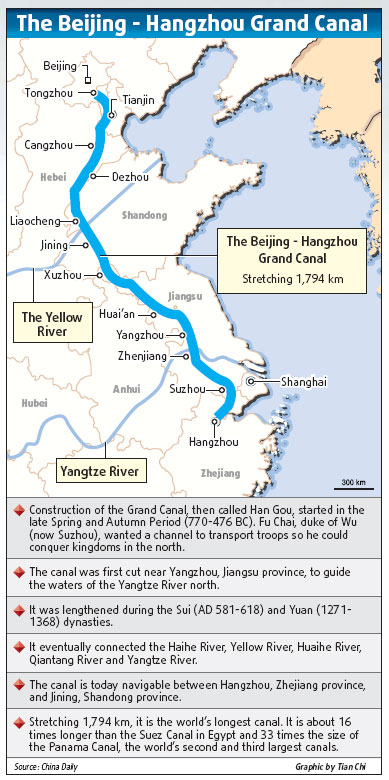
|
CHINA> Focus
 |
|
The forgotten jewel of ancient China
By Lin Shujuan (China Daily)
Updated: 2009-06-23 09:45 It has existed for more than 2,500 years and has been a vital vein through which China's lifeblood has flowed, but conservation experts say the ancient Grand Canal is an all but forgotten relic that some people have no interest in protecting. China announced this month it would be putting the world's oldest and longest man-made waterway forward in 2014 as its candidate to join the Great Wall on the UNESCO World Cultural Heritage list. A total of 35 cities are working on the "unprecedented" bid, the State Administration of Cultural Heritage said.
Chinese experts said they hope the bid, if successful, would boost efforts to preserve a site many still fail to recognize as one of immense importance. Many agree, however, the move is decades overdue. "People know all about the Great Wall but they have no idea about the Grand Canal because people often only take notice of large and imposing constructions, not low-level attractions such as a waterway," said Zhang Tinghao, former director of the Beijing-based National Cultural Relics Research Institute. "The fact the canal doesn't look any different from other waterways also makes it easier for people to take it for granted." The failure to see the value of the Grand Canal, especially the cultural landscape it has helped define for past 2,000 years, has resulted in it being neglected, said Luo Zhewen, president of China Cultural Relics Academy and one of the country's leading experts in ancient architecture.
"But few would have. It was still working then, and a cultural relic was something people associated with static or 'dead' things, such as the Great Wall." The Grand Canal was not even recognized as a national cultural relic site until 2005, he added. As tourism has boomed over recent years, rushed conservation projects by towns and cities to turn areas of the canal into glitzy attractions have also put the waterway at risk. Sections in the picturesque and popular cities of Hangzhou, Zhejiang province, and Yangzhou, Jiangsu province, have undergone major renovations, while the Beijing section has also been transformed into a waterside park suitable for cycling. Stretches, mostly in the north, have also dried and become impassable by boat, while some areas have been reduced to industrial cesspools by persistent pollution. "The canal is more than a tourist attraction," said Shan Jixiang, director of State Administration of Cultural Heritage, who criticized cities where officials have destroyed historic sections to garner the canal with cement plazas and manicured lawns. "It would be a disaster to see the canal have its treasure of stories drained by such a process." The waterway, which was started in the late Spring and Autumn Period (770-476 BC), runs from Hangzhou to Beijing, winding through some of China's most fertile and heavily populated lands. Stretching almost 1,800 km, it is about 16 times longer than the Suez Canal in Egypt and 33 times the size of the Panama Canal, the world's second and third largest canals.
 |
||||||